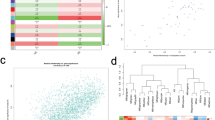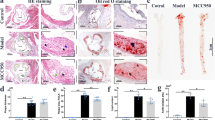Abstract
Aim:
To investigate the effects of the glucagon-like peptide-1 (GLP-1) receptor agonist exendin-4 on oxidized low-density lipoprotein (ox-LDL)-induced inhibition of macrophage migration and the mechanisms underlying the effects of exendin-4.
Methods:
Primary peritoneal macrophages were extracted from the peritoneal cavity of mice treated with 3% thioglycollate (2 mL, ip). Migration of the macrophages was examined using a cell migration assay. Macrophage migration-related factors including leptin-like ox-LDL receptor (LOX-1), cyclooxygenase 2 (COX-2), tumor necrosis factor (TNF)-α, interleukin-1 (IL-1)β, matrix metalloproteinase-2 (MMP-2), intercellular adhesion molecule (ICAM)-1 and macrophage migration inhibitory factor (MIF) were measured using semi-quantitative RT-PCR. Expression of MIF and ICAM-1 proteins was examined with ELISA. Gelatin zymography was used to evaluate the activity of MMP-9. Activation of the NF-κB pathway was determined by confocal laser scanning microscopy.
Results:
Treatment of the macrophages with ox-LDL (50 μg/mL) markedly suppressed the macrophage migration. Furthermore, ox-LDL treatment substantially increased the expression of the macrophage migration-related factors, the activity of MMP-9 and the translocation of the NF-κB p65 subunit. These effects of ox-LDL were significantly ameliorated by pretreatment with the specific NF-κB inhibitor ammonium pyrrolidine dithiocarbamate (100 μmol/L). These effects of ox-LDL were also significantly ameliorated by pretreatment with exendin-4 (25 and 50 nmol/L).
Conclusion:
Exendin-4 ameliorates the inhibition of ox-LDL on macrophage migration in vitro, via suppressing ox-LDL-induced expression of ICAM-1 and MIF, which is probably mediated by the NF-κB pathway.
Similar content being viewed by others
Log in or create a free account to read this content
Gain free access to this article, as well as selected content from this journal and more on nature.com
or
References
Celermajer DS, Chow CK, Marijon E, Anstey NM, Woo KS . Cardiovascular disease in the developing world: prevalences, patterns, and the potential of early disease detection. J Am Coll Cardiol 2012; 60: 1207–16.
Hansson GK, Robertson AK, Söderberg-Nauclér C . Inflammation and atherosclerosis. Ann Rev Pathol 2006; 1: 297–329.
Goyal T, Mitra S, Khaidakov M, Wang X, Singla S, Ding Z, et al. Current concepts of the role of oxidized LDL receptors in atherosclerosis. Curr Atheroscler Rep 2012; 14: 150–9.
Park YM, Febbraio M, Silverstein RL . CD36 modulates migration of mouse and human macrophages in response to oxidized LDL and may contribute to macrophage trapping in the arterial intima. J Clin Invest 2009; 119: 136–45.
Daoud AS, Jarmolych J, Augustyn JM, Fritz KE . Sequential morphologic studies of regression of advanced atherosclerosis. Arch PatholLab Med 1981; 105: 233–9.
Llodrá J, Angeli V, Liu J, Trogan E, Fisher EA, Randolph GJ . Emigration of monocyte-derived cells from atherosclerotic lesions characterizes regressive, but not progressive, plaques. Proc Natl Acad Sci U S A 2004; 101: 11779–84.
Wissler RW, Vesselinovitch D . Studies of regression of advanced atherosclerosis in experimental animals and man. Ann N Y Acad Sci 1976; 275: 363–78.
Bernink FJ, Timmers L, Diamant M, Scholte M, Beek AM, Appelman Y, et al. Effect of additional treatment with EXenatide in patients with an Acute Myocardial Infarction (EXAMI): study protocol for a randomized controlled trial. Trials 2011; 12: 240.
Ban K, Hui SY, Drucker DJ, Husain M . Cardiovascular consequences of drugs used for the treatment of diabetes: potential promise of incretin-based therapies. J Am Soc Hypertens 2009; 3: 245–59.
Ussher JR, Drucker DJ . Cardiovascular biology of the incretin system. Endocr Rev 2012; 33: 187–215.
Nikolaidis LA, Mankad S, Sokos GG, Miske G, Shah A, Elahi D, et al. Effects of glucagon-like peptide-1 in patients with acute myocardial infarction and left ventricular dysfunction after successful reperfusion. Circulation 2004; 109: 962–5.
Noyan-Ashraf MH, Shikatani EA, Schuiki I, Mukovozov I, Wu J, Husain M, et al. A glucagon-like peptide-1 analog reverses the molecular pathology and cardiac dysfunction of a mouse model of obesity. Circulation 2013; 127: 74–85.
Ng DS, Saw NM . The role of HDL and its modulators in the development of diabetes. Curr Opin Lipidol 2012; 23: 167–8.
Arakawa M, Mita T, Azuma K, Ebato C, Goto H, Watada H, et al. Inhibition of monocyte adhesion to endothelial cells and attenuation of atherosclerotic lesion by a glucagon-like peptide-1 receptor agonist, exendin-4. Diabetes 2010; 59: 1030–7.
Burger-Kentischer A, Goebel H, Seiler R, Fraedrich G, Schaefer HE, Ihling C, et al. Expression of macrophage migration inhibitory factor in different stages of human atherosclerosis. Circulation 2002; 105: 1561–6.
Larson DF, Horak K . Macrophage migration inhibitory factor: controller of systemic inflammation. Crit Care 2006; 10: 138.
Olefsky JM, Glass CK . Macrophages, inflammation, and insulin resistance. Ann Rev Physiol 2010; 72: 219–46.
Libby P, Lee RT . Matrix matters. Circulation 2000; 102: 1874–6.
Schmeisser A, Marquetant R, Illmer T, Graffy C, Garlichs CD, Strasser RH, et al. The expression of macrophage migration inhibitory factor 1alpha (MIF 1alpha) in human atherosclerotic plaques is induced by different proatherogenic stimuli and associated with plaque instability. Atherosclerosis 2005; 178: 83–94.
Khan S, Shin EM, Choi RJ, Jung YH, Kim J, Tosun A, et al. Suppression of LPS-induced inflammatory and NF-κB responses by anomalin in RAW 264.7 macrophages. J Cell Biochem 2011; 112: 2179–88.
Knapinska A, Fields GB . Chemical biology for understanding matrix metalloproteinase function. Chembiochem 2012; 13: 2002–20.
Molloy KJ, Thompson MM, Schwalbe EC, Bell PR, Naylor AR, Loftus IM . Comparison of levels of matrix metalloproteinases, tissue inhibitor of metalloproteinases, interleukins, and tissue necrosis factor in carotid endarterectomy specimens from patients on versus not on statins preoperatively. Am J Cardiol 2004; 94: 144–6.
Toth M, Sohail A, Fridman R . Assessment of gelatinases (MMP-2 and MMP-9) by gelatin zymography. Methods Mol Biol 2012; 878: 121–35.
Sturge J, Todd SK, Kogianni G, McCarthy A, Isacke CM . Mannose receptor regulation of macrophage cell migration. J Leukoc Biol 2007; 82: 585–93.
Shin EM, Zhou HY, Guo LY, Kim JA, Lee HL, Merfort I, et al. Anti-inflammatory effects of glycyrol isolated from G uralensis in LPS-induced macrophages. Int Immunopharmacol 2008; 8: 1524–32.
Park YM, Febbraio M, Silverstein RL . CD36 modulates migration of mouse and human macrophages in response to oxidized LDL and may contribute to macrophage trapping in the arterial intima. J Clin Invest 2009; 119: 136–45.
Cao C, Lawrence DA, Strickland DK, Zhang L . A specific role of integrin Mac-1 in accelerated macrophage efflux to the lymphatics. Blood 2005; 106: 3234–41.
Silverstein RL, Li W, Park YM, Rahaman SO . Hanisms of cell signaling by the scavenger receptor CD36: implications in atherosclerosis and thrombosis. Trans Am Clin Climatol Assoc 2010; 121: 206–20.
Condon JC, Jeyasuria P, Faust JM, Mendelson CR . Surfactant protein secreted by the maturing mouse fetal lung acts as a hormone that signals the initiation of parturition. Proc Natl Acad Sci U S A 2004; 101: 4978–83.
de Groot D, Haverslag RT, Pasterkamp G, de Kleijn DP, Hoefer IE . Targeted deletion of the inhibitory NF-kappaB p50 subunit in bone marrow-derived cells improves collateral growth after arterial occlusion. Cardiovasc Res 2010; 88: 179–85.
Hansson GK, Hermansson A . The immune system in atherosclerosis. Nat Immunol 2011; 12: 204–12.
Permana PA, Menge C, Reaven PD . Macrophage-secreted factors induce adipocyte inflammation and insulin resistance. Biochem Biophys Res Commun 2006; 341: 507–14.
Gong Y, Hart E, Shchurin A, Hoover-Plow J . Inflammatory macrophage migration requires MMP-9 activation by plasminogen in mice. J Clin Invest 2008; 118: 3012–24.
Hofnagel O, Luechtenborg B, Weissen-Plenz G, Robenek H . Statins and foam cell formation: impact on LDL oxidation and uptake of oxidized lipoproteins via scavenger receptors. Biochim Biophys Acta 2007; 1771: 1117–24.
Nagashima M, Watanabe T, Terasaki M, Tomoyasu M, Nohtomi K, Hirano T, et al. Native incretins prevent the development of atherosclerotic lesions in apolipoprotein E knockout mice. Diabetologia 2011; 54: 2649–59.
Asare Y, Schmitt M, Bernhagen J . The vascular biology of macrophage migration inhibitory factor (MIF). Expression and effects in inflammation, atherogenesis and angiogenesis. Thromb Haemost 2013; 109: 391–8.
Kong YZ, Yu X, Tang JJ, Ouyang X, Huang XR, Fingerle-Rowson G, et al. Macrophage migration inhibitory factor induces MMP-9 expression: implications for destabilization of human atherosclerotic plaques. Atherosclerosis 2005; 178: 207–15.
Robker RL, Collins RG, Beaudet AL, Mersmann HJ, Smith CW . Leukocyte migration in adipose tissue of mice null for ICAM-1 and Mac-1 adhesion receptors. Obes Res 2004; 12: 936–40.
Sueyoshi S, Mitsumata M, Kusumi Y, Niihashi M, Esumi M, Sakurai I, et al. Increased expression of peroxisome proliferator–activated receptor (PPAR)-alpha and PPAR-gamma in human atherosclerosis. Pathol Res Pract 2010; 206: 429–38.
Acknowledgements
This work was supported by grants from the National Natural Science Foundation of China (81273496 and 81172974), the “Simcere Innovation Fund” (CX11B-004XS), the Project Program of State Key Laboratory of Natural Medicines, China Pharmaceutical University (SKLNMZZ201211), the “333” Project of Jiangsu Province, and the National High Technology Research and Development Program of China (863 Program) (2013AA092901).
Author information
Authors and Affiliations
Corresponding authors
Rights and permissions
About this article
Cite this article
Ma, Gf., Chen, S., Yin, L. et al. Exendin-4 ameliorates oxidized-LDL-induced inhibition of macrophage migration in vitro via the NF-κB pathway. Acta Pharmacol Sin 35, 195–202 (2014). https://doi.org/10.1038/aps.2013.128
Received:
Accepted:
Published:
Issue date:
DOI: https://doi.org/10.1038/aps.2013.128



